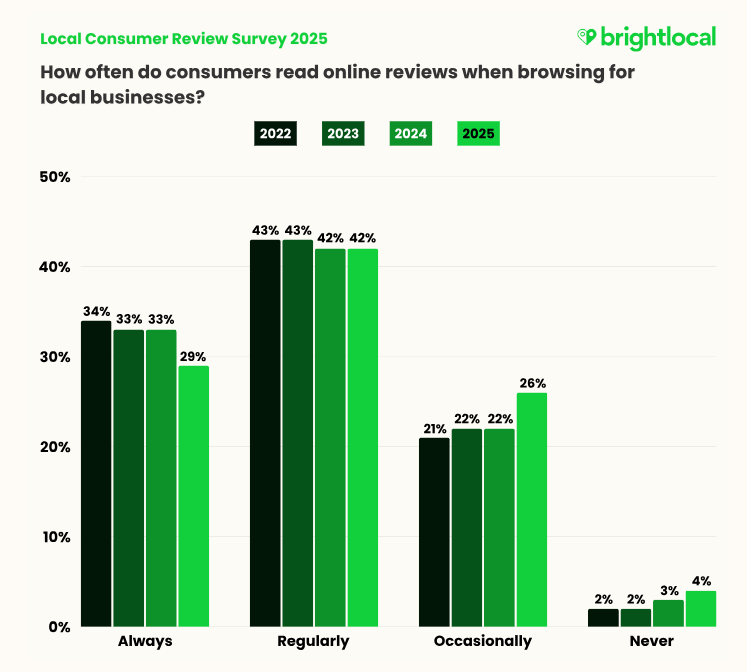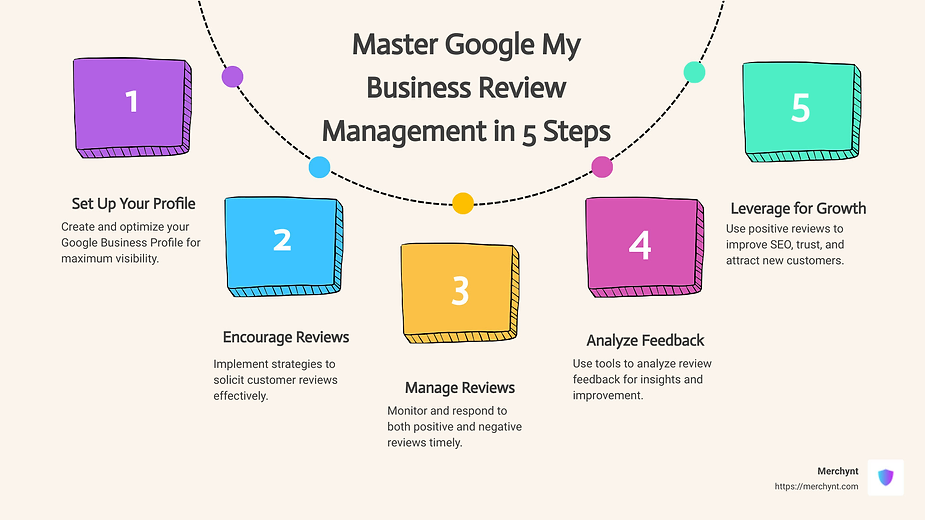It’s a regular day; you’re scrolling through your GMB profile to see how customers find your services. All’s well until you suddenly see the one thing you dread the most:
A brutal one-star review from a customer with an angry rant about how no one should trust your business. Quite a buzzkill, right?
You might want to ignore it or try to get it removed. But here’s something you might not expect: with the right approach, negative reviews can actually help your business.
According to BrightLocal’s Local Consumer Review Survey 2025, 42% of consumers say they read online reviews regularly, while browsing businesses, and consider them as much as personal recommendations from friends or family.

This guide will show you how to turn negative reviews into chances to boost your reputation and improve your search rankings. Let’s get started!
Why Reviews Matter for Your Spa or Salon
Having negative Google reviews isn’t all doom and gloom for your business. Here’s how these reviews impact your business for the better:
How Google Reviews Affect Your SEO
Responding to reviews can boost your local search rankings. Google loves businesses that stay active and interact with their clients. When you consistently reply to reviews and engage with feedback, your business profile is more likely to show up in local search results.
Building Social Proof with Reviews
Handling negative reviews in a calm and genuine way shows people that you're honest and open. When potential clients see both positive feedback and thoughtful responses to complaints, they know your business is real, trustworthy, and cares about its customers. To help your team manage these situations consistently, you might adopt a simple service-recovery script such as, "I hear you; let's fix this together." This repeatable phrase can demonstrate genuine care and offer a unified approach to addressing client concerns.
Reviews as Trust Signals for New Clients
Professional, thoughtful responses attract new clients who value businesses that care. Your attention to feedback shows your commitment to customer satisfaction.
Operational Insights from Negative Reviews
Try to look at negative reviews as helpful feedback. They can reveal patterns and give you a chance to improve your services. These insights can help with staff training and create a better experience for your clients.
How Customers Interpret Reviews - Customer Psychology
Did you know that 88% of consumers are more likely to pick a business that replies to all its reviews? When people invest their time, money, and trust in you, it’s natural for them to feel strongly if things don’t go as expected. But here’s the thing: when future clients read your reviews, they’re not really interested in the drama. They just want to see how you handle challenging situations and whether you genuinely care about making things right.
Why Do Clients Leave Negative Reviews?
Ever wonder what drives a client to leave a negative review? Most of the time, it’s not just one thing; it’s a mix of little moments that add up. Here are some of the most common reasons clients decide to share their disappointment online:
- Unmet Expectations: Perhaps the result didn’t match their expectations, or something was lost in communication. When clients leave feeling let down, they’re more likely to speak up.
- Timing and Scheduling Issues: Nobody likes waiting around or dealing with last-minute changes. If appointments run late or the schedule feels chaotic, frustration can build quickly.
- Price vs. Value: Clients are happy to pay for excellent service, but if the results don’t feel worth the price, it’s natural for them to express that disappointment in a review.
- Staff Behavior: A friendly, welcoming team goes a long way. On the flip side, a rude or inattentive interaction, even if unintentional, can stick with a client long after they leave.
- Cleanliness, Hygiene, and Ambience: People notice the details, especially in a spa or salon setting. If the space isn’t spotless or the atmosphere feels off, clients may start to question your professionalism.
- COVID Safety Concerns: These days, clients expect visible safety and hygiene measures. If they feel protocols aren’t up to par, they may mention it in a review.
- Unresolved Issues: Sometimes, all a client wants is to feel heard. If their concerns aren’t acknowledged or addressed, leaving a review can seem like the only way to get your attention.
By understanding these triggers, you can take steps to prevent negative feedback and create experiences that keep clients coming back and raving about you online.
What Potential Clients Really Look For in Negative Reviews
- How the Owner Responds: Most readers check if you replied, and whether your response is polite, professional, and empathetic.
- Whether Issues Are Resolved: People want to see real solutions offered, not just apologies. This reassures them that their concerns will also be heard.
- Patterns in Complaints: Customers look for repeated issues versus one-off problems. Consistent complaints are a red flag, while a single negative review isn’t as worrying.
- Details in Reviews: Specific, detailed reviews carry more weight than vague one-liners. They help future clients understand what went wrong and how your business handled it.
Step-by-Step Guide: How to Manage Negative Google Reviews
Learning how to handle negative reviews can help you win back unhappy clients and build a stronger, more trustworthy reputation for your salon or spa. Here’s how you can manage negative reviews effectively:
Step 1: Stay Calm and Assess the Review
A negative review can hurt, but try not to let it upset you too much. Take a moment to pause before you respond. Focus on finding solutions instead of looking for someone to blame.
Start by:
- Reading the review carefully. What is the client really upset about?
- Checking your records: When was the appointment? What service did they receive? Who helped them?
- Talking to your staff to get their perspective. Keep it constructive.
- Asking yourself how urgent this review is. Does it need your immediate attention, or can you take a little time to craft the right response?
- Assessing the possible impact. Could this review turn away potential clients if left unaddressed?
- Most importantly, shift your mindset to: “How can I make this better?” Once you focus on finding solutions, you’re already making progress.
Step 2: Investigate the Issue
After you’ve taken a moment, look more closely at the situation. Don’t respond right away. Gather all the facts first so you understand what really happened and avoid misunderstandings.
Start by:
- Contacting the Customer: Initiate contact with the client to gather more context. A simple, friendly message, such as, “We’re sorry to hear about your experience and would love to learn more to make things right. Can we reach out?” works well.
- Collecting Staff Feedback: Speak with the team members involved to understand their perspectives. This will help you piece together the entire scenario and clarify any misunderstandings.
- Looking at the Client’s Service History: Check the client's service history to identify patterns or special needs that explain their feedback. Understanding their previous experiences can provide valuable context if this is a regular client.
- Documenting Key Details: Keep track of critical details in a shared document. Note down customer contacts, staff inputs, and any initial requirements. This helps with consistency and follow-ups.
Step 3: Craft Your Response
Once you have all the facts, you can respond to the review. This is your opportunity to show the reviewer and others that you care about fixing the problem.
Start by:
- Responding Promptly: Aim to reply within 24 to 48 hours. A quick response shows you’re attentive and value your clients’ feedback.
- Choosing the Right Tone and Language: Be polite, calm, and understanding. Avoid getting defensive or making excuses. Let your words show that you’re open to feedback and want to help.
- Using a Clear Response Structure:
- Greet the client by name if possible.
- Thank them for sharing their experience.
- Acknowledge what they went through and show empathy.
- Offer a sincere apology if appropriate.
- Explain any steps you’re taking to address the issue, or invite them to talk privately.
- End on a positive note, encouraging future contact or another visit.
Examples: How to Respond to Google Reviews
Not sure what to say? Here are some examples of thoughtful, effective responses to negative reviews, and why they work.
Scenario 1: Vague Negative Review
Review: The Service was very disappointing.
Response: Hi Jane, we’re sorry to hear you weren’t delighted with your visit. Your feedback is essential for improving, so we’d love to know more. Please reach out to us so we can make things right.
Why this works: It shows empathy, invites more details, and lets the client know you want to resolve the issue.
Scenario 2: Aggressive Complaint
Review: Worst experience ever. Unfriendly staff and wasted my money!
Response: Hi Mary, we’re sorry your visit didn’t meet your expectations. We strive to make every client feel valued and regret that we missed the mark. We’d appreciate the opportunity to discuss this with you and see how we can improve. Please get in touch with us.
Why this works: It acknowledges the client’s feelings, takes responsibility, and invites a private conversation.
Scenario 3: Service Quality Issue
Review: The facial was poorly done; I have acne all over my face now.
Response: Hi Sarah, we apologize for your facial not meeting our quality standards. We appreciate your feedback and would love to offer a complimentary redo at your convenience. Please reach out to schedule a time that works for you.
Why this works: It directly addresses the issue, offers a solution, and encourages the client to return.
Scenario 4: Result Dissatisfaction
Review: I asked for a subtle hair color and ended up with something too bright.
Response: Hi Maya, we’re sorry your hair color wasn’t what you envisioned. We aim to match your expectations perfectly, and we regret falling short. We invite you back for a color adjustment to achieve your desired look. Please get in touch with us so we can set this up.
Why this works: It acknowledges the gap between expectation and result, and offers a specific remedy.
Step 4: Follow Up for Resolution
After you reply to the review, take the next step and work to resolve the client’s issue.
Start by:
- Checking In After Your Response: Reach out within a day or two after your initial response. A quick call or email can reinforce your commitment to resolving issues immediately.
(💡Zoca helps automate email and SMS outreach so you can reach your clients anytime for feedback!)
- Offering a Solution: Depending on the situation, consider offering a free service or discounts to encourage the client to return and rebuild trust.
- Rebuilding Loyalty: Once the issue is resolved, send a thank you note or extend a special offer to show your continued appreciation and care.
Step 5: Update Your Public Response
After you’ve resolved the client’s concern, let others know by adding a brief update to your review reply.
- Resolution Update Example: Once the issue is resolved, update the original review response with a note like, “Thank you, Maya, for allowing us to address your concerns. We’re glad we could make things right and appreciate your feedback.
Step 6: Learn and Improve from Reviews
Each review is an opportunity to improve your business. Take time to think about the feedback and use it to make changes.
- Spot Patterns: Review feedback regularly to spot recurring issues. Knowing what needs improvement, such as timing, communication, or quality, helps shape better practices.
- Use Insights for Training: Use insights from reviews to tailor training sessions. Highlight areas needing attention, such as customer service techniques or technical skills, so your team continues to grow and enhance their service.
How to Spot and Handle Fake Reviews
Being proactive protects your business reputation and shows potential clients that you handle all reviews, whether real or fake, responsibly.
How to Identify Fake Reviews
Just like how you can instantly tell when someone’s gotten on fake lashes or nails, spotting fake reviews is easy. Look out for:
- Generic, overly negative language that lacks detail.
- Reviews from profiles with no history or incomplete info.
- Repeated similar reviews across different businesses.
- Reviews that don’t match your customer records.
Reporting Fake Reviews to Google
- Use the platform’s “Report” or “Flag” option to alert moderators.
- Support your claim by providing evidence, such as appointment records or customer history.
- Follow up with the platform if necessary to expedite the process.
How to Respond to Suspected Fake Reviews
- Reply politely and professionally. Example:
“We’re unable to find your appointment in our records. If you believe this is a mistake, please contact us directly so we can help.” - Avoid arguing or making accusations in your public reply.
- Show transparency and demonstrate that you care about real customer experience.
Tactics to Prevent Fake Reviews
- Encourage real customers to leave detailed reviews to outweigh and dilute the fake ones.
- Monitor your review platforms regularly to catch suspicious activity early.
- Educate your staff to recognize and report fake reviews when they spot them.
How to Prevent Negative Reviews in the Future
It’s always better to prevent problems before they happen. Here are some ways to reduce negative reviews in the future:
- Set Clear Expectations From the Start: Transparent communication is the key to happy clients. Explain your services, pricing, and policies before the appointment. Discuss realistic outcomes during consultations to avoid misunderstandings and unmet expectations. A well-informed client is less likely to leave negative feedback.
- Invest in Staff Training Programs: Regular training ensures that your team provides top-notch service and effectively handles client concerns. Equip your staff with customer service skills emphasizing listening, empathy, and conflict resolution. This can reduce complaints stemming from misunderstandings or poor interactions.
- Ask for Feedback Early: Check in with clients before they leave. A simple “How was your visit today?” can help you catch issues before they become public.
- Maintain Quality Control Measures: Check your service quality often by asking clients for feedback, using feedback loops, or having a manager observe. This helps you catch problems early and avoid negative reviews.
- Stay on Top of Communication: Establish clear, professional communication protocols for all staff to follow. These protocols should include appointment reminders, service updates, and post-service care advice. Clear and courteous communication reduces misunderstandings and enhances customer experience.
💡If doing all this manually feels tricky, try Zoca to see how we can automate client communication in a few clicks!
How to Measure Your Success
By consistently tracking a few metrics, you can fine-tune your approach, identify patterns, and ensure that your review management process translates into stronger client relationships and business growth.
To gauge how well your review management efforts are working, keep an eye on these key metrics:
Track Your Google Business Profile Insights
Check your profile regularly for metrics like views, clicks, and customer actions. This data shows how reviews impact customer engagement and overall online visibility.
Check out the image below for a quick overview of the five key steps to master Google My Business review management.

Alt-text: Master Google My Business review management in 5 steps, an infographic showing key actions for handling and responding to reviews effectively
Monitor Your Review Response Rate
Keep an eye on how quickly and often you reply to reviews. Responding to all feedback, especially negative comments, within 24–48 hours shows you care and builds trust with clients.
Measure Your Resolution Success
Track how many issues you successfully resolve after a client leaves a review. A high success rate means you’re turning unhappy clients into satisfied ones.
Track Your Customer Return Rate
Check if clients are returning after their issues have been resolved. Repeat business is a strong signal that you’re earning back trust.
Use Zoca for Google Review Management
Responding to Google reviews and keeping up with client feedback can feel overwhelming, especially when you’re already juggling a busy spa or salon. Missed messages or delayed responses can impact your reputation and make it harder to build lasting client relationships.
That’s where Zoca comes in. Zoca automates your client communication, helping you easily reach out for feedback, nurture customer loyalty, and stay connected with your clients through automated SMS and email outreach. By simplifying how you ask for and receive feedback, Zoca makes managing your Google reviews much easier and helps you focus on providing excellent service.
Ready to see how Zoca can take the stress out of review management? Check out Zoca today!
Zoca follows up, replies instantly, and secures bookings while you focus on your craft.



